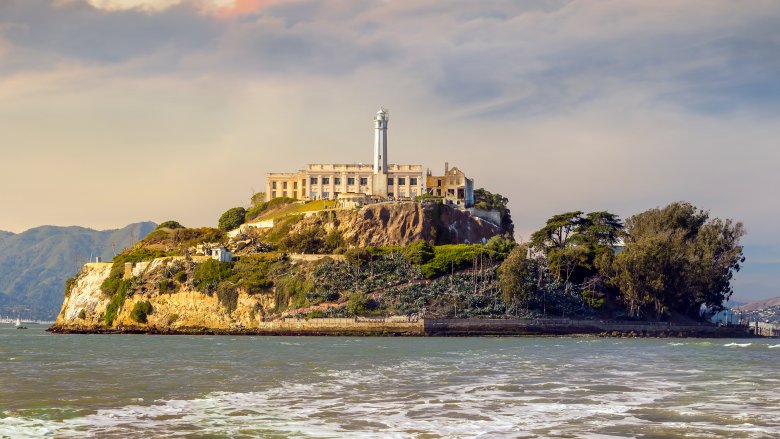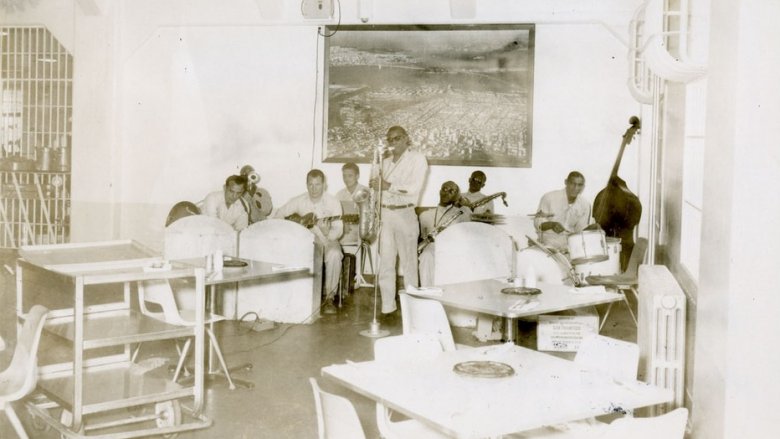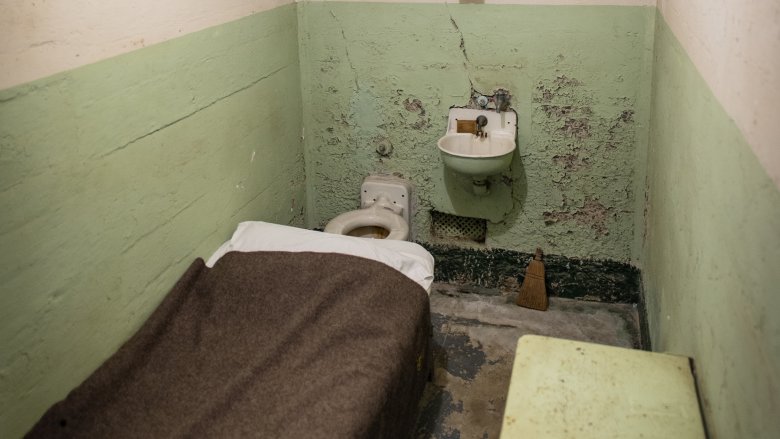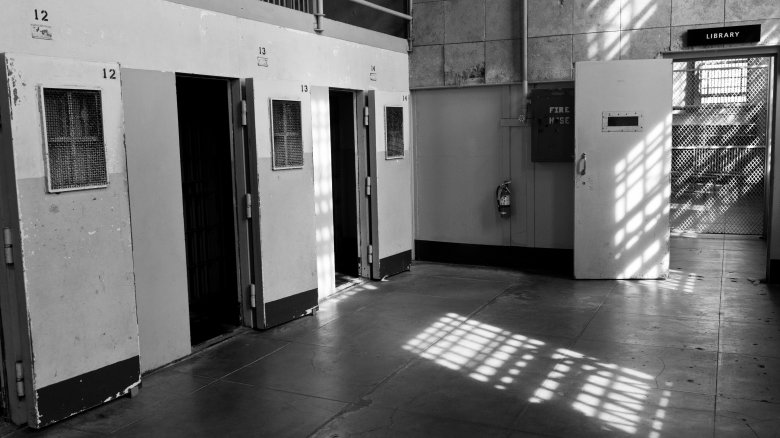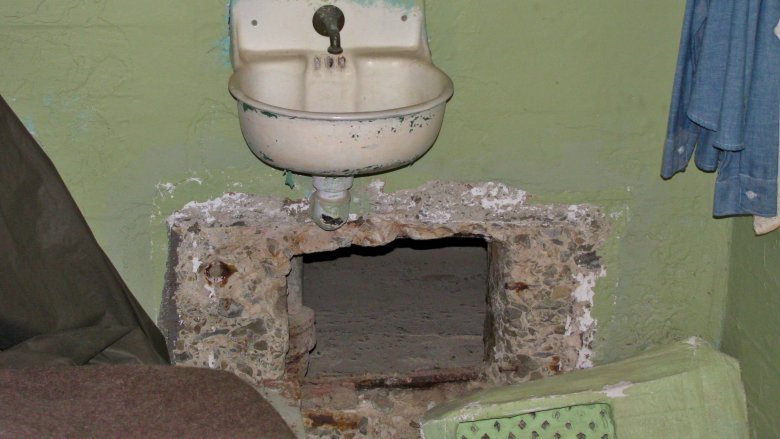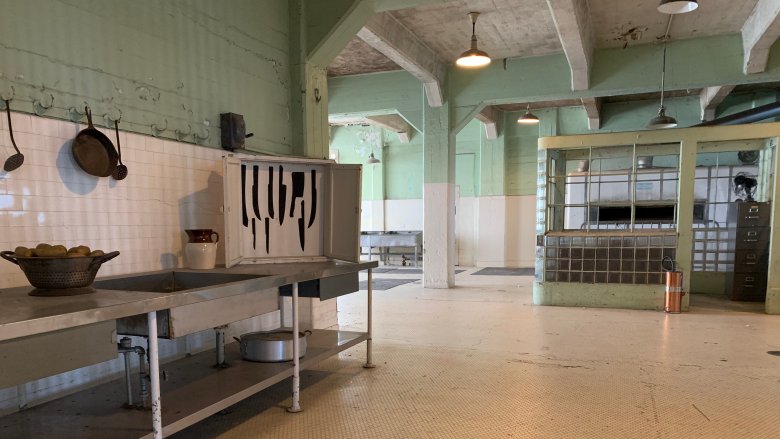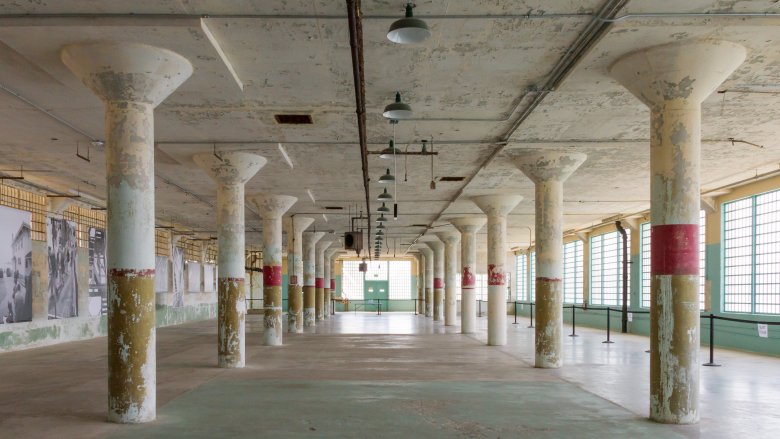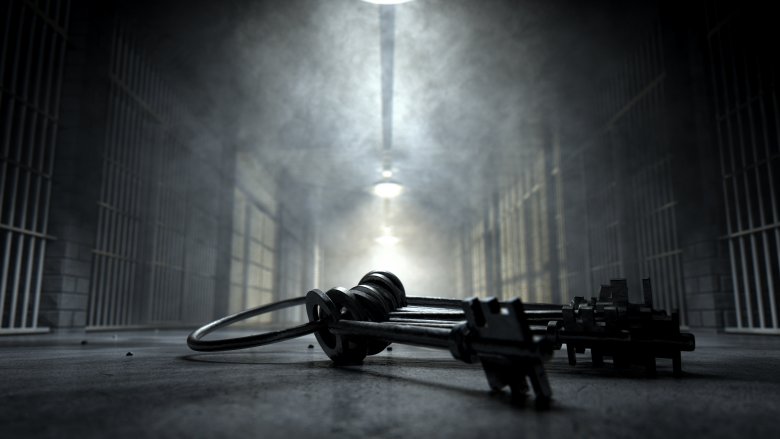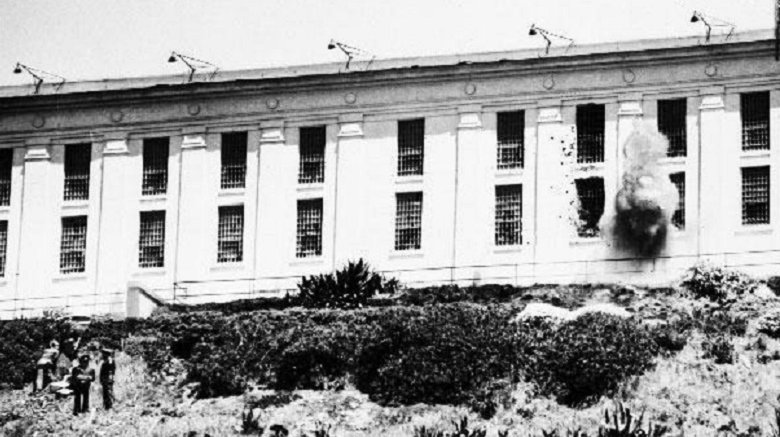What Life In Alcatraz Was Really Like
Alcatraz Federal Penitentiary, aka the Rock, has gone down in history as the most formidable prison of all time. Even when it was open, newspaper carried stories of how hardcore it was, and everyone knew only the worst criminals were sent there. It was supposed to be escape-proof, so ending up there meant abandoning all hope of leaving before you served your time. Since it closed, plenty of books and movies have contributed to its fearsome reputation.
But while it certainly wasn't a nice vacation in San Francisco, Alcatraz might not have been as bad as the legend suggests. The prison population was tiny — Alcatraz was never filled to capacity, and the most prisoners it ever held was 302. It was meant for short stints of a few years to straighten prisoners out that had been a problem in other facilities, and people were usually only there for about eight years. And while they were there, amazingly, they could have a bit of fun. Here's what life on Alcatraz was really like.
Al Capone played banjo in a prison band
Al Capone was the most famous inmate Alcatraz ever had. But part of the reason he was sent there was not because no other prison could hold him, but because he was having way too much fun in the one they originally put him in. According to Smithsonian.com, during his time in an Atlanta prison, Capone bribed all the guards and got special privileges in return, including a constant stream of visitors. He tried to do the same on Alcatraz, but the warden wasn't having any of it. Capone was just like any other inmate. He did get his way once, though. He "begged the warden for permission to form a small band."
Called "The Rock Islanders" (pictured, without Capone), Alcatraz History says there were 12 members and two alternates. They practiced during the week in the barbershop, and they sometimes gave concerts on Sunday afternoons. Capone wrote his son, relishing in his musical hobby, saying, "First I learned a Tenor Guitar and then a Tenor Banjo, and now the Mandola, but for Solo work only," and bragging he knew over 500 songs. He even composed his own music, with one love song called "Madonna Mia," published posthumously in 2009. One ex-inmate told reporters Capone had become "a pretty fair banjo player."
The band (also called the "regular orchestra") seems to have been a hit, because the chaplain formed a string orchestra as well. Eventually, there were 30 men playing instruments, with 10 of them giving monthly concerts.
Alcatraz had perks other prisons didn't
For all its fearsome reputation as a barren rock no one could escape from, some inmates in other prisons actually requested transfers to the terrible Alcatraz. This would appear to make the opposite of sense. But bizarrely, the island had some perks that made staying there relatively decent. However, as The Vintage News points out, the nice things were really just a disguise for better security.
Take the prison food, for example. Alcatraz's first warden knew that prisoners were more likely to riot if their meals were terrible. So he served decent grub. One menu from the 1940s included "bacon jambalaya, pork roast with all the trimmings, or beef pot pie Anglaise." Inmates were also allowed as many helpings as they wanted. While the cells on the Rock were tinier than normal, they only housed one man. Not having a cellmate was something the prisoners loved, and it meant they were less likely to be attacked by one of their own who couldn't deal with their snoring any longer.
Perhaps the best perk was the showers. As shown in the above image, the actual equipment was nothing special, and there was no privacy. But it was what came out of the shower head that was luxurious. Unlike other prisons, Alcatraz allowed its inmates access to "moderately hot water." The idea was they wouldn't get used to the normal brisk ones, and therefore if they ever tried to escape, the freezing bay water would be even more of a shock.
Kids were running around the place
Believe it or not, many Alcatraz guards chose to live on the island itself. The rent was cheap, the commute was short, and they were allowed to bring their families. This meant children lived in close proximity to some of the country's worst criminals.
According to History Collection, over 100 kids grew up on Alcatraz (some were even born there). They had happy childhoods, playing baseball, flying kites, roller skating, or competing in soapbox derbies. There was a game room with pool tables and a jukebox. The only difference was if they were on the playground and an alarm sounded, they had to run straight home. The kids were also banned from owning toy guns (for obvious reasons) and playing cops and robbers, although some parents snuck in the contraband, and children would play secretly at home. Most of the island was off limits, but kids being kids, that was just another fun game, sneaking around where they weren't allowed.
They even interacted with the inmates. Many prisoners were employed as maintenance workers, and kids would wave or talk to them as they picked up garbage or fixed the plumbing in guards' homes. One man who grew up there says his father made it a point for him to meet and talk to convicts. Some former residents even claim to have Al Capone stories. One woman says he repaired her shoes for her and signed the bottom, while a man swears he shook the gangster's hand in the hospital once.
The silence was deafening
There was one rule on Alcatraz considered so harsh that it only lasted a few years. Like in a monastery, there were strict limits on when prisoners could talk. History says, effectively, this meant "nearly complete silence was mandated at all times." Even the most introverted inmate was going to start losing it under those conditions. Alcatraz History reports prisoners hated it. The San Francisco Chronicle even ran a headline in 1935 declaring "Alcatraz Silence Awful."
The convicts couldn't speak to each other or the guards when standing in line, when being moved around the prison, or even when eating, except to order their food. The only times they could converse freely were in the exercise yard on the weekends or at work in the factory. Desperate, many inmates drained the water from their toilets and found a way of communicating through the sewage pipes. Anyone caught talking during quiet time was punished severely. The rule was dispensed with in the late 1930s, less than five years after it was instituted.
Even once inmates were allowed to talk more freely with each other, their speech was controlled in other ways. While inmates were allowed one visitor a month (provided the warden approved it), they were not allowed to discuss any current events with their guests. Guards supervised every visit to make sure no one crossed a verbal line, and all conversations were held through an intercom.
Punishment was no fun on Alcatraz
Prisoners on Alcatraz were expected to follow the strict rules. When they didn't, there was punishment. This might involve being locked in their cells, losing privileges, or even being force fed. But the worst offenders were sent to D-Block (pictured), where the really bad stuff happened.
Some of the stories of punishment come down to if you believe the warden and guards or the convicts. Inmates, for example, insisted under oath that they were beaten, while the warden swore that didn't happen in his prison. And it's definite that Alcatraz didn't have certain tools of physical punishment that were common at the time and would be considered torture today, because the warden wouldn't allow them. But then there was the "Strip Cell."
Crime Magazine explains there were 42 cells in D-Block, with varying levels of punishment. The Strip Cell was the worst. It was a small, steel-encased room with no light and no toilet — nothing but a small hole in the floor for waste. Inmates were put in there naked and given a very limited meal. At night, they were given a thin mattress, but it was removed during the day. It was so bad that most inmates were only put in there for one to two days, and legally, they couldn't be held there for more than 19. A step up from the Strip Cell was the Hole, but it was still terrible. One ex-inmate wrote a book about his experience in it (via The Telegraph) and said the cold and isolation were unbearable.
Escape attempts were extremely rare
While prisoners might sit in their cells dreaming about escaping, very few of the ones on Alcatraz ever actually attempted it. The Rock was known as the country's most secure prison, and criminals there seem to have decided it wasn't worth trying. The vast majority simply resigned themselves to serving out their time.
The exceptions were few and far between. According to Alcatraz History, in the 29 years the prison was open, 36 men were involved in 14 escape attempts. None of them succeeded (probably), and only two of the 36 men tried twice. However, 23 were caught in the act, six were shot and killed during their attempts, and at least two drowned in the freezing bay. Tthe other bodies were never recovered.
The most infamous escape attempt, made into the movie Escape from Alcatraz starring Clint Eastwood, involved three men who some people think actually managed it. It's almost certain they drowned or succumbed to hypothermia, but no one knows for sure. Other attempts to flee were just as interesting. One prisoner who worked in the laundry room stole a complete army uniform piece by piece over time, then put it on and just walked onto a boat. Unfortunately, it wasn't headed to San Francisco, and he was quickly apprehended. One man actually did survive the swim across the bay, but by the time he made it to shore, he was suffering from shock, and some teenagers found him and brought him to a hospital, where the jig was up.
Strikes weren't just for unions
Prisoners might not have tried to escape often, but that didn't mean they were always happy inside. When they got upset, sometimes they went on strike.
Alcatraz History says the biggest was in January 1936, when around 60 percent of the convicts stopped working. The trouble started in the laundry room, and the group got bigger and bigger, until the guards had to lock 120-130 inmates back in their cells. Each one was interrogated, and they said they wanted more privileges, and they couldn't go back to work because breaking the strike would make them "rats." The inmates all started yelling, and five ended up in solitary. The next day, 24 inmates who worked in the kitchen joined the strike, and the guards had to cook food instead. Seven more prisoners ended up in solitary. Everyone locked in their cells who refused to work was only given water. When they finally got food again, some went on hunger strike and were force fed. By the end of the month, everyone returned to work.
In September 1937, The Madera Tribune reported on yet another strike. It's thought that news of a major escape attempt in Folsom State Prison that month might've made its way into Alcatraz somehow and sparked the strike. That time, about 100 inmates sat down in their cells and refused to go to work. Anyone that didn't give in was thrown in solitary. The warden said it was just an attempt by the prisoners to "draw attention to themselves."
Prisoners got to work, if they were good
Inmates need things to do, or they get bored, which means they get aggressive, and that's something guards want to avoid at all costs. After all, nobody wants a bunch of shankings. So even the hardened criminals on Alcatraz were given jobs, as long as they were well-behaved.
Alcatraz 101 reports there was a wide variety of occupations on offer, although one warden pointed out that a lot of the guys ended up in prison because they didn't have the skills for honest work, so matching inmates with tasks could be difficult. Many helped run the prison itself, doing the cooking and cleaning, while others were involved with dock work or maintenance. But the vast majority worked in a massive factory on the island (pictured). There they might toil in the laundry facilities, but mainly, it was all about producing things like shoes, gloves, rubber mats, brooms, brushes, raincoats, and furniture, which is similar to prisons today. They also helped repair buoys used in the bay, and during World War II, they did their patriotic duty making cargo nets for the Navy.
Inmates sometimes got unexpected days off due to the weather. San Francisco is notoriously foggy, and the men who worked in the factory had to be marched from their cell blocks, outside, and down to the other building. When the island was absolutely covered in fog, it was too hard for the guards to keep an eye on the prisoners during this journey, so work was canceled.
Alcatraz inmates had plenty of fun
Life in Alcatraz wasn't all sitting in cells and working. Inmates were allowed to have fun. Prisoners could borrow from the library, with each reading an average of seven books and three magazines a month, per Alcatraz History. There were biweekly church services for the spiritual. And in the yard, men played chess, checkers, horseshoes, and dominoes. The more athletic could try their hand at baseball or handball. In 1936, 60 inmates took part in a serious softball league. And the intellectuals could sign up for 19 different correspondence courses, including disparate choices like Poultry Husbandry, Elementary English Literature, the Beginning of Civilization, and Beginning Algebra.
One of the major forms of entertainment was gardening. According to The Gardens of Alcatraz, the so-called Rock was actually a great place for plants, thanks to the military importing soil to the island in the 1800s. When the federal Bureau of Prisons took over in 1933, the warden's secretary started taking care of the plants and convinced the warden to let prisoners help, too. They worked with horticulturalists to transform the Rock into a paradise. Inmate Elliott Michener worked on the gardens for nine years and got so into it that he was given special permission to order seeds and bulbs. He later said the hobby was the start of a "lasting interest in creativity." The gardens were so beautiful and historic that they were restored in 2003.
Everybody thought it was haunted
These days, people like to think Alcatraz is haunted because of the violent deaths that occurred there and the fact it's a creepy old abandoned building. But even when it was full of prisoners, there were many ghost sightings. It seems guards and inmates alike were constantly dealing with eerie happenings.
Legends of America says guards heard phantom cannons and gunshots, which would send them diving for cover, thinking the inmates had inexplicably gotten their hands on a siege weapon somehow. A laundry room was said to fill with smoke as if it was on fire, only for it to be perfectly clear minutes later. There were reports of screaming, sobbing, and moaning, all with no obvious cause. There were horrible smells and sudden drops in temperature. The US military used the island for almost 100 years before it was a prison, and one haunting involved an old-timey soldier.
Modern, sensational retellings of alleged Alcatraz hauntings say this specter was so common the guards made a joke out of it. It became "The Thing," a man dressed in late 1800s-style clothing with glowing red eyes and said to haunt D-Block. Once, a prisoner was locked in solitary and supposedly started screaming that someone with red eyes was in there with him. The guards ignored him, and he screamed for hours, then silence. In the morning, they found the inmate dead. (If this really happened, he was probably ... silenced by a guard, but maybe it just didn't really happen.)
The Battle of Alcatraz
In general, Alcatraz was a peaceful place. But it was a prison, so obviously there were some exceptions. In addition to six men shot during escape attempts, eight people were murdered by inmates. But considering how dangerous the guys inside were, and the fact that Alcatraz was open for 29 years, that's not as bad as one might expect. Even prison riots weren't common. However, there was one glaring exception to the mostly peaceful record.
In 1946, there was an escape attempt that the Encyclopedia Britannica calls "unprecedented in its violence." Inmate Bernard Coy had noticed the bars on the room holding the guards' guns could be pulled apart slightly, so he lost 20 pounds in order to squeeze through, according to SFGate. On May 2, Coy and five co-conspirators put their escape plan into action. They beat a guard, stole his keys, and started opening cells. Coy managed to squeeze into the gun gallery. But then the plan went wrong. The key ring didn't have the one needed to open the cell block. The convicts had weapons but couldn't go anywhere.
Finally, the alarm sounded, and for the next 48 hours, "the Battle of Alcatraz" raged. Coy fired on the guards. The military showed up and launched grenades at the building (pictured). On May 4, guards finally stormed the cell block. In the end, three of the six convicts were dead (two others would get the death penalty for their part in the escape). As for the guards, 12 were wounded, and two were killed.
